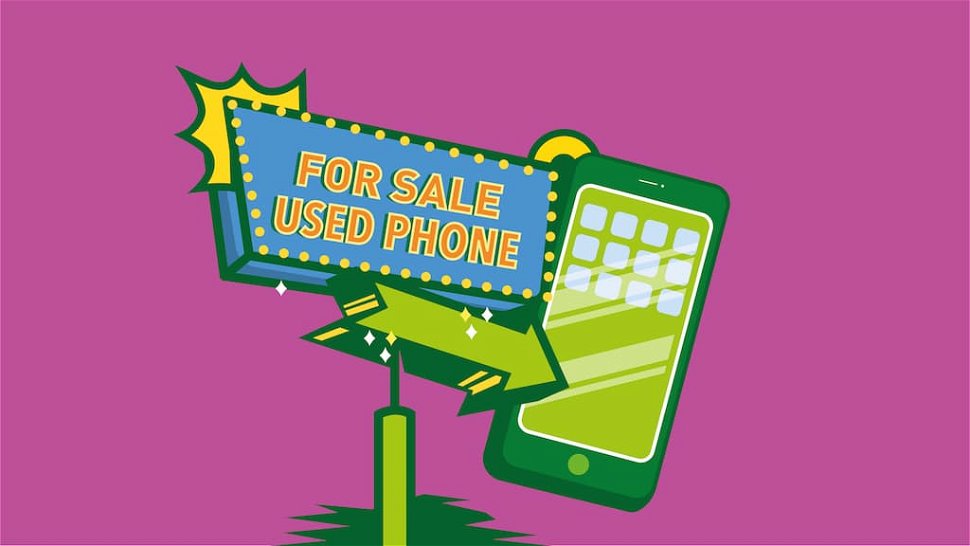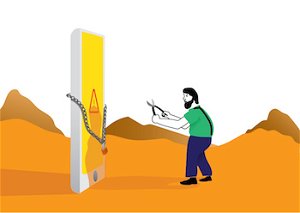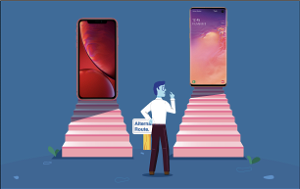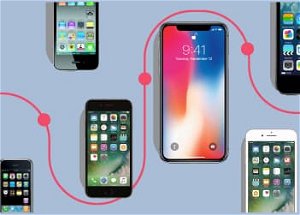
Want to buy a used phone but worried about being ripped off?
This guide will help you minimise risk to find a great phone at a great price!
We’ll break things down into three sections:
Let’s get started!
Where to Find Great Used Phone Deals
From stolen or broken phones to scammers that don’t have a phone at all, the hazards of trying to buy a used phone are plentiful.
However, if you can sort out the good offers from the bad, buying a used phone is a great way to land a phone at a price your local network or retail stores can’t touch.
1. Skip the Hassle with a Reputable Resale Site
Want to enjoy some of the savings of buying used without the hassles and risks of dealing with a random person on the Internet?
Swappa is a reputable site built around buying and selling used phones.
While you might not get the lowest price possible, you get the comfort of advanced screening of any sellers to ensure things are legit.

If you need service as well, Cell Swapper allows people to sell both their phone and their plan.
This is great for ensuring you don’t end up with a blacklisted phone as you assume the entire mobile contract!
Always read the policies of the site before purchasing as they are subject to change.
If the site allows you to purchase from other users, check their feedback or account history to be sure you’re dealing with someone trustworthy.
If the sale you’re considering is their only sale or there’s any negative feedback in their history, it could hint to issues or a fake account used to scam buyers.
2. Check Out Online Classified and Auction Sites
While you won’t enjoy the protections of the sites mentioned above, online classifieds and auction sites offer some of the best deals available.
Unfortunately, they come with added risk of scams or misrepresented items as well.

Popular options include:
You can also search your favourite social media sites for local sellers.
For example, many areas have at least one local “buy/sell/trade” group on Facebook.
When working with online options, you’ll need to verify the listings and pay close attention to listings to get the most savings.
3. Don’t Forget Local Options
With the way that the Internet is tied into daily life, it’s easy to overlook some of your local options.
When looking for used phone deals, be sure to check the following places:
- Pawn shops
- Thrift stores or consignment shops
- Local classifieds
- Small electronics repair shops
- Community boards in grocery stores, post offices or on local college campuses
If you’re meeting up with someone locally to buy a phone, we have tips in this guide to help you spot bad phones or shady sellers. Keep reading.
Finding an Online Phone Deal You Can Trust
With where to look out of the way, lets talk about what to look for--including common red flags when finding a seller online and tips to help you find the best deals.
Knowing Phone Values will Help You Screen Deals
Whether you’re buying from a seller or a service, knowing the market value of the phone you want is one of the easiest ways to screen legitimate deals.
Search multiple sites for the exact model you’re considering and note the average price.

As with anything else in life, if the deal seems too good to be true--it probably is.
If you end up scammed, you won’t be saving much--if anything--over a new phone.
Better to pay a reasonable price and know things are okay than risk it for savings that might not exist.
Find Sales with Verifiable Information to Eliminate Scams
Another easy way to check sellers off the list is checking the information in the sales post.
Sellers using stock images or the same image on every ad or auction shouldn’t be trusted.
 If you suspect that a seller might be using fake photos, request a new picture with the date and time written on a piece of paper included in the frame.
If you suspect that a seller might be using fake photos, request a new picture with the date and time written on a piece of paper included in the frame.
If the seller will not take a few seconds to snap a picture, how do you think they’ll respond if your phone isn’t what you expected?
Also check the accuracy of specifications listed in the ad.
While we all make mistakes, if they’re intentionally boosting features and specs for the phone, they might be hiding something else.
Lastly, check the ad to ensure that any accessories you might need come with the phone.
While it might not seem like a big deal, a full kit of accessories--include charging adapters, cords, styluses or cases--shows that someone likely took good care of their device.
Not to mention that the price of accessories adds up.
If you can find a bundle with everything, you’ll probably save more money.
Ask Questions to Get a Feel for the Seller
If the site you’re using allows you to ask questions, do so.
Even if you already know all about the phone, you can gauge responses to get a feel for the person on the other side of the screen.
If responses are slow and short, they might be fielding too many emails--an indication that they might be trying to pull something shady.
If they cannot provide basic information about the phone--or you simply get a weird feeling about their responses--take that listing out of the running!
This includes responses such as, “I don’t know. I’m selling it for a friend.”
If they don’t have access to the device for any reason, you don’t want to risk it.
Don’t Fall for the “New in Box” Trick
That phone’s still shrink wrapped and features a shiny new label from the store or network!
That must mean it’s the best option, right?
Not always.
First, it’s easy to shrink wrap a box that’s already been opened.
Secondly, if it’s still wrapped, it could be an indication that it’s stolen.
Ethics aside, even if it works, it probably won’t take long to end up on a blacklist after you activate it.
You’ll have an expensive paperweight and the seller gets to have fun with your cash.
Always check out why the seller is selling a “new in box” item.
If it’s still wrapped and recently purchased, they should be able to return it for more than their making selling it online.
If their story doesn’t line up, avoid the deal!
Check the IMEI When Possible to Avoid Issues Later
Every mobile phone has a unique number known as its International Mobile Equipment Identifier (IMEI) attached to it.
 If a device is reported lost, stolen or destroyed, the phone is blacklisted--meaning it cannot connect to the network network.
If a device is reported lost, stolen or destroyed, the phone is blacklisted--meaning it cannot connect to the network network.
This can also happen if a phone is subsidized through a network but the owner doesn’t meet their contract terms.
To help protect people from buying blacklisted phones, a number of sites offer IMEI checking tools.
Typically the best option is to use the IMEI check of your mobile network. Another option is the Swappa tool.
Of course, to run the check you’ll need the IMEI.
If the seller has the original packaging, it’s often printed on a network label.
Otherwise, typing “*#06#” into most smartphones will display the IMEI.
If they claim that they cannot find it, you can check our guide on blacklisting for additional options.
When Possible Insist on Meeting Up to Finalise the Sale
Being able to meet a person and look at the phone before buying it adds an extra level of protection and additional opportunities for you to verify that the device is in working condition.

If the person is supposedly nearby but unwilling to meet, it could indicate that they are hiding something.
If you must purchase online and rely on someone to ship the device, using PayPal or another popular payment service will add some protections to your purchase if the device isn’t what you expected or--worse still--never shows up.
NOTE: Regardless of whether you meet in person or arrange shipping, never pay in cash! This leaves you zero recourse if the sale is a scam.
Things to Check When Meeting a Seller In-Person
With a deal lined up and a meeting arranged, there’s a few more things to check before you’re in the clear.
From where to meet to checking out the phone before you hand over your hard-earned money, we'll cover everything you need to consider.
These lists might look intimidating, but most checks only take a few seconds.
You should be able to complete everything listed in under 5 minutes.
SAFETY NOTE: Always meet with the seller in a public place. Since you’re buying a phone, a place with reliable Wi-Fi is even better. Meeting during the day and bringing a friend will also help to improve safety. If you have any doubts, call off the meeting. You can always find another deal. There’s only one you!
Ask More Questions
When meeting the seller, ask a few more questions and pay attention to how they respond.
The person might be nervous meeting you, so some awkwardness is not a big deal.
If the person is acting suspicious, providing inconsistent answers or isn’t able to answer simple questions it might indicate something more is going on.
Physically Inspect the Phone
Even if the phone looks great, taking the time to check everything thoroughly will ensure there’s no surprises after money is swapped.
Check each of these features if possible:
If the phone has a removable back:
Check for Water Damage
Water damage is tricky.
While the phone might look and function great now, a phone that has water damage might not show signs until months later.
Then again it might not show signs at all.
At the least, this gives you something you can ask the seller to check if they’re being honest.

This check is also important if the seller is charging more due to a remaining warranty or protection plan from the manufacturer--such as Apple’s AppleCare.
Most manufacturer and retailer plans do not cover devices with water damage, even if the reason for the claim has nothing to do with water exposure.
Checking for water exposure is easy.
Most phones include water-sensitive stickers inside the phone’s various openings that change colour when exposed to excess moisture.
Some use circles while other use squares.
Colours might also vary.
However, most will use a sticker that is grey or white to start and turns pink, red or purple when wet.
Locations to check on phones include:
For locations to check on most Apple devices, consult Apple’s water damage support page.
Verizon offers places to look on most Samsung, HTC, Motorola and LG phones.
If you still cannot find the indicators on a phone, a quick Google search for “Checking for water damage” and the model of the phone will give you some tips.
Check Common Phone Functions
With most physical indicators out of the way, it’s time to test how the device functions.
If you’ve arranged to meet at a coffee shop, you might even have Wi-Fi and a power connection nearby to make testing even easier.
Considerations include:
Get a Bill of Sale to Avoid Future Worries
Without a paper trail, proving who sold or bought what is hard.
To help protect both you and seller, creating a bill of sale for the phone purchase is recommended.
Not sure what to include in the bill of sale?
Our Informr-exclusive template makes things simple. If you print it out and fill in your details before meeting up, the seller can sign it in a few seconds and be on their way! We even include copies of the check lists above so you don't have to worry about forgetting an important detail.
OPTIONAL: Try to Get the IMEI Noted on Both Accounts
If everything looks good and you’re planning to purchase the phone, see if the seller would mind hanging around for a few minutes while you call the network and get the phone assigned to your account. This should avoid any additional worries about receiving a blacklisted phone.
If the seller is super awesome, see if they’d mind calling their network with you’re there to have a note added that the phone is no longer on their account.
This prevents them from later calling and reporting the phone stolen or filing an insurance claim for a replacement.
These two steps aren’t always possible.
Unfortunately, if they aren’t done, you remain at risk for blacklisting.
The exact amount of time varies by network or country.
In some cases, it’s as little as a month, in others, you might never be fully in the clear.
This is one of the flaws in the current blacklisting system.
Without the official notes, all that’s left is trusting the seller.
This is the biggest reason why if anything at all about the seller seems off, you should walk away immediately.
Final Thoughts
It's not hard to find used phone horror stories online.
However, with some research and understanding of the pitfalls to avoid, you can enjoy a great deal on a used phone with little worry.
- If you're not comfortable buying from a person, there's entire businesses built around selling used phones.
- Whether you buy online, in person or in store, paying with a credit card or PayPal further increases your protections.
- Regardless of how you pay, be sure to meet in a safe place and use our checklists to thoroughly inspect the phone before any money trades hands.
You’re now equipped to go out and find an awesome phone deal!
Do you have any tips we might have overlooked?
Have other questions about where to find great phone deals or what to look out for?
We want to hear from you! Leave us a comment in the box below!








